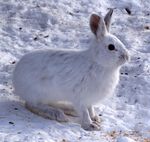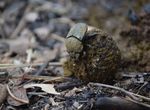TAHOME NATURE EDUCATION: WINTER ANIMAL OLYMPICS GRADES K-5 - TAHOE INSTITUTE FOR NATURAL ...
←
→
Page content transcription
If your browser does not render page correctly, please read the page content below
TaHome Nature Education: Winter Animal Olympics
Grades K-5
Reading: Amazing Tahoe Animal Adaptations
If non-human animals were permitted to participate in our athletic competitions, humans might never win any Olympic
events again, let alone qualify to enter some of the events that other animals would dominate. Humans would no longer
win strength competitions or races on foot or in the water, nor would they even be represented in flying or other
physical feats of birds, fish, insects, and more. Tahoe animals have some pretty amazing physical abilities. How do you
think your physical abilities compare?
American Black Bears have very powerful forelegs and can run over 30 mph, although
this doesn’t happen often. This means they can run 100 meters in about seven
seconds. The world record for a human running 100 meters belongs to Olympian
Usain Bolt, who ran the distance in 9.58 seconds in 2009, running at around 28 mph.
Northern Flying Squirrels are a hard to find Tahoe local, as they stay hidden during the
day and come out at night. A better name for this mammal might be “gliding”
squirrels, as they use a special flap of skin between their front and back legs to glide
through the air between trees. This skin membrane is hard to see on a squirrel unless
they are in the air, when they spread out their limbs. Some daring people use “squirrel
suits” to mimic this body shape and gliding ability for big jumps from high cliffs.
However, humans still need parachutes to help them touch down again safely. Flying
squirrels move their legs to steer and use their tail to slow down when they land on a
American Black Bear tree. In a single jump, flying squirrels can cover over 150 feet.
Snowshoe Hares are so named for their Snowshoe Hare
ability to float on top of deep snow, thanks to their large feet. When
people strap on snowshoes, these devices help spread out our weight on
the snow, to make us sink less and travel more easily on the snow.
Snowshoe Hares have wide back feet, covered in warm fur, that are as long
as five inches (more than a 1/4 the size of their entire body length). In
comparison, human feet are usually only 1/6 the length of our bodies.
Snowshoe Hares also adapt to winter with changes to their fur. During the
summer, their fur can be a mix of gray, brown, red, white, and black. In
winter months, their fur becomes almost entirely white to blend in with
the snow and hide from predators.
Copyright Tahoe Institute for Natural Science 2021Dung Beetles also get their name from something that makes them unique. Dung Beetle
They are known for rolling feces into balls, which they then feed on. These
insects fly around looking for deposits of manure from animals like cows or
horses using specialized antennae that can detect the smell of fresh dung in the
air. Next, they will roll the dung into a ball and push it away to be buried for
either food or for laying eggs. These amazing bugs can move dung balls that are
50 times heavier than themselves! If you weighed 100 lbs., you would have to
be able to roll a ball weighing 5,000 lbs. to be as strong as these beetles. Dung
Beetles are also ferocious fighters, with horn-like body parts and strong legs,
and some are known to use the Milky way to navigate.
Clark’s Nutcrackers are known for their amazing memories. In autumn months, these local
birds pry open Whitebark Pine cones to access their seeds. Then, the Clark’s Nutcrackers
cache these pine nuts by burying them underground where they can find them throughout
the winter, even in deep snow. This smart bird leaves 4-5 seeds in each cache (but as many as
15!), and can hide up to 90,000 seeds total annually. That means they may remember
between 5,000 and 20,000 different caches in a year! The seeds that they leave behind or end
up not needing, are not wasted; they grow into groups of Whitebark Pine trees in Tahoe’s
mountains.
Each of these Tahoe animals, and many more, have amazing skills that help them to survive
and thrive in their habitats. Humans may not be able to run as fast as bears or jump as far as
Clark’s Nutcracker squirrels, but we have some unique strengths as well. In particular, humans are great at using
tools. Tools you might commonly use include silver wear to help you eat your food, shoes to
keep your feet warm and dry, ropes and ladders to climb, and phones to communicate from far away. Human tool use
allows us to mimic some of the abilities of animals, like squirrel suits and snowshoes. What other tools can you think of
that would help you mimic the abilities of other animals like the Clark’s Nutcracker, Dung Beetle, and American Black
Bear?
Copyright Tahoe Institute for Natural Science 2021Olympic Events
Run like an American Black Bear
These bears run 100 meters in 7 seconds, but can you come close? Time yourself running 100 meters (or the length of a
straight side on a track). Try as many times as you like, but be careful running on snow or ice! Record your time in the
Winter Animal Olympic Scorecard below.
Jump like a Northern Flying Squirrel
Can you travel 150 feet in one jump like a Flying Squirrel? Mark your starting point. Then, from a standstill, jump as far
forward as you can. Stay where you land and have someone measure the distance you jumped from your marked
starting point. Record the length of your jump in the Winter Animal Olympic Scorecard below.
Float like a Snowshoe Hare
Snowshoe Hares travel easily through the snow, thanks to their large feet that spread out their weight over a large
surface area. On snow that is at least several inches deep, try walking upright without making holes in the snow. Next,
try walking on hands and knees without making holes in the snow. Finally, try spreading out your weight even more by
army crawling through the snow, trying to keep your whole body on the ground. In the Winter Animal Olympic
Scorecard below, record which method worked best for traveling through deep snow without post holing for you.
Roll like a Dung Beetle
Dung Beetles can roll balls of feces 50 times their own weight! Create a snowball and roll it around the ground collecting
more snow and making the ball as large as you can, until you can no longer roll it with your own strength. Measure how
tall this snowball has become. Record the height of your snowball in the Winter Animal Olympic Scorecard below.
Remember like a Clark’s Nutcracker
Clark’s Nutcrackers can remember and find 20,000 hidden caches of food each year. Play a game of Memory. You can
play with matching pictures at home, or play online. Turning over two pictures at a time, try to make matches by
learning where the match to each picture is in the group. Record the fewest turns it takes you to make all the matches.
Winter Animal Olympic Scorecard
Run like an American Black Bear
I can run 100 meters in ____________ seconds.
Jump like a Northern Flying
Squirrel
I can jump ___________ feet.
Float like a Snowshoe Hare
I can travel through deep snow without sinking
by ____________________________________.
Roll like a Dung Beetle
I can roll a snowball that is _______ inches high.
Remember like a Clark’s
Nutcracker
I can win Memory in ________ turns.
Use tools like a Human
As you complete the above physical challenges, you may notice that it is hard to even come close to doing as well as
these different animals. However, if you use tools to help you, you may be able to travel as fast as an American Black
Bear or move a heavy snowball. Try these challenges again, but this time try using different tools to see how you can
improve your abilities. Tell a friend or family member about what tools you used and how they helped you better mimic
animal adaptations.
Copyright Tahoe Institute for Natural Science 2021Words to Know
Membrane: A thin layer of tissue on the body.
Mimic: To imitate someone or something.
Cache: To store or hide for future use.
Adaptation: A naturally occurring trait that helps an animal or plant
survive in their habitat.
Palabras para conocer
Membrana
Imitar
Flying Squirrel
Esconder
Adaptación
Further Learning
Watch Flying Squirrels in action.
See a Dung Beetle rolling balls of feces.
Learn about the Snowshoe Hare research TINS conducts.
Copyright Tahoe Institute for Natural Science 2021You can also read

























































